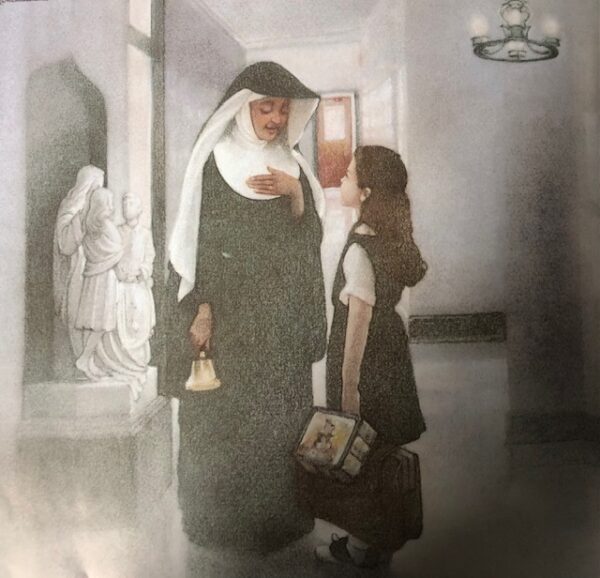Sister Anne’s Hands: Book Review (Catholic Black History)
Catholic Black History Month Series: Sister Anne’s Hands, written by Marybeth Lorbiecki and illustrated by Wendy Popp
February is Black History Month, a month we set aside to appreciate the experiences and contributions of African Americans in the United States. In honor of Black History Month, I will review black history-themed books over the next few weeks. These books may interest Catholic homeschool families. Additionally, this will prove helpful if you’re planning a Catholic Black History Month unit study or deep dive into the topic.
Book Overview: Sister Anne’s Hands
Today I am reviewing the picture book Sister Anne’s Hands (Puffin Books, 1998). Sister Anne’s Hands tells the story of a Catholic schoolgirl’s first encounter with racism in the 1960s when an African American nun comes to teach at her parochial school. The experience becomes a learning opportunity for two people of different races, bonded by their shared Catholic faith.
Anna, a seven-year-old girl from a Polish Catholic family, attends a traditional parochial school taught by nuns in the 1960s. It is the age of the civil rights movement and integration, and Anna’s family learns that a “colored” nun will teach Anna’s class. This is Sister Anne, a humble and patient sister who impresses young Anna with her kindness and engaging teaching style. Unfortunately, an ugly outburst of racism serves as a reminder that even a Catholic classroom is not immune from the country’s racial turmoil. Nonetheless, Sister Anne turns the incident into a teaching moment. With truth and grace, she wins a place in the hearts of her students and forever changes Anna’s perception.
Impressions of the Book
This book is around 40 pages long, but with large font and most pages dedicated to the beautiful illustrations, it can easily be read in ten minutes. Overall, I was quite impressed with the book for several reasons:
The Illustrations
First, the wonderful art of illustrator K. Wendy Popp. The illustrations are done in pastels. This is an extremely challenging medium that makes Popp’s skillful execution here doubly impressive. I have seen K. Wendy Popp’s pastel illustrations in other works, and she has a way of utilizing the “dusty” nature of pastels to give her illustrations a hazy, dreamlike quality. This method works exceptionally well in Sister Anne’s Hands. It gives the illustrations a nostalgic feel reminiscent of a 1960s photograph. There are plenty of gorgeous depictions of traditional Catholic parochial school life—images, as the illustrator relates on the dedication page, that were crafted from observations made in a real Catholic parochial school.

The Writing
The writing is excellent. Without giving away too much, I particularly appreciated how the author, Marybeth Lorbiecki, chose to situate Sister Anne’s response to the racist incident within the Catholic idea of encountering God through openness to others, as taught in the Beatitudes and parables of Christ. It is another way the work is not just another commentary on racism but a commentary from a Catholic perspective.
Historical Context and Authenticity
I naturally wondered whether this book was based on a true story. We are never told. The acknowledgments page mentions Sr. Anne Thompson, to whom the book is dedicated. I assume she may have inspired Sister Anne in the story. Whether or not the events of Sister Anne’s Hands ever occurred, there must certainly have been thousands of stories similar to what the book relates. Thus, it is a true characterization of what this period was like, even if the details may not have occurred.
Target Audience
I have no real criticisms of this book, save a nitpick that it is marketed for children 4 to 8 years old. That is, the text assumes historical knowledge that I’m sure most 4- to 8-year-olds do not possess. For example, it mentions “flower power” and The Ed Sullivan Show in passing without explaining what these cultural icons were. I’m fairly certain that no 4- to 8-year-old in the 2020’s knows what The Ed Sullivan Show is. In fact, many parents probably don’t know what it is today. However, this does provide the opportunity for a teaching moment.
Some authors like including these sorts of details because they prompt kids to ask, “What’s The Ed Sullivan Show?” Then, the parent explains, and it facilitates an educational encounter between parent and child. I personally don’t like this approach as much simply because it disturbs the narrative—the parent must stop reading the story to explain the reference to the child. I do, however, understand this is merely my preference. And even so, there are not many occasions of this in the book, so it’s not a huge deal.
Conclusion and Recommendation
Overall, I highly recommend Sister Anne’s Hands. It was competently written and beautifully illustrated. Additionally, thematically, it is difficult to find books that address America’s complex racial history within a Catholic framework. The setting of Sister Anne’s Hands within a parochial school, with the titular character being a Catholic nun, makes this book ideal for broaching this subject within a Catholic homeschool. As I said, it’s not a long book (you can easily get through it in a single sitting), but you might find it worth incorporating into a larger unit on this subject or within your elementary American history class when you cover the Civil Rights era.
Sister Anne’s Hands can be purchased on Amazon.
Would you like to connect with other Catholic homeschooling parents? To continue the discussion, join me and other homeschooling parents at our Homeschool Connections Community or our Facebook group!
Bonus
Would you like to learn more about the Civil Rights Movement yourself? Or would you like to add the subject to your homeschool curriculum? Check out Homeschool Connections’ recorded, self-paced course Civil Rights in America, 1863-1968: Setbacks, Struggles, and Shockwaves taught by Dr. Christopher Martin. Recorded courses can be taken individually or as a part of our Unlimited Access program.
Note: This article contains affiliate links.






